
Rise of the Triad: Dark War is a first-person shooter video game, developed and published by Apogee Software in 1995. The player can choose one of five different characters to play as, each bearing unique attributes such as height, speed, and endurance. The game's story follows these five characters who have been sent to investigate a deadly cult, and soon become aware of a deadly plot to destroy a nearby city. Its remake was designed by Interceptor Entertainment and released by Apogee Games in 2013. The shareware version of the game is titled Rise of the Triad: The HUNT Begins.
Commander Keen is a series of side-scrolling platform video games developed primarily by id Software. The series consists of six main episodes, a "lost" episode, and a final game; all but the final game were released for MS-DOS in 1990 and 1991, while the 2001 Commander Keen was released for the Game Boy Color. The series follows the eponymous Commander Keen, the secret identity of the eight-year-old genius Billy Blaze, as he defends the Earth and the galaxy from alien threats with his homemade spaceship, rayguns, and pogo stick. The first three episodes were developed by Ideas from the Deep, the precursor to id, and published by Apogee Software as the shareware title Commander Keen in Invasion of the Vorticons; the "lost" episode 3.5 Commander Keen in Keen Dreams was developed by id and published as a retail title by Softdisk; episodes four and five were released by Apogee as the shareware Commander Keen in Goodbye, Galaxy; and the simultaneously developed episode six was published in retail by FormGen as Commander Keen in Aliens Ate My Babysitter. Ten years later, an homage and sequel to the series was developed by David A. Palmer Productions and published by Activision as Commander Keen. Another game was announced in 2019 as under development by ZeniMax Online Studios, but was not released.
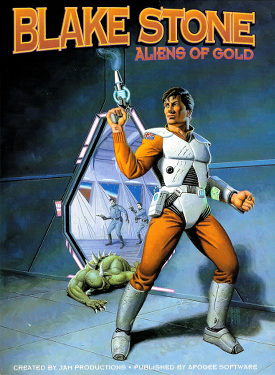
Blake Stone: Aliens of Gold is a first-person shooter for DOS created by JAM Productions and published by Apogee Software on December 5, 1993. The following year, a sequel called Blake Stone: Planet Strike was released, which continues where Aliens of Gold leaves off. Some copies of the game provided a Command Control Gravis Gamepad.

Crystal Caves is a side-scrolling platform game developed and published by Apogee Software for IBM PC compatibles. The game is divided into three episodes with the first distributed as shareware and the other two available for purchase. Designer Frank Maddin said the method worked "pretty well" for the time. Crystal Caves was inspired by the 1982 Atari 8-bit family game Miner 2049er.

Duke Nukem is a 1991 platform game developed and published by Apogee Software for MS-DOS. The 2D, multidirectional scrolling game follows the adventures of fictional character Duke Nukem across three episodes of ten levels each. The game's first episode was distributed as shareware. The name was briefly changed to Duke Nukum to avoid trademark issues.
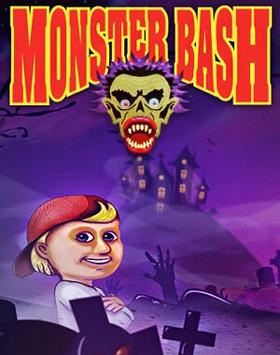
Monster Bash is a side-scrolling platform game developed and published by Apogee Software on 9 April 1993 for DOS. The game features 16-color EGA graphics and IMF AdLib compatible music. It was developed by Frank Maddin and Gerald Lindsly.
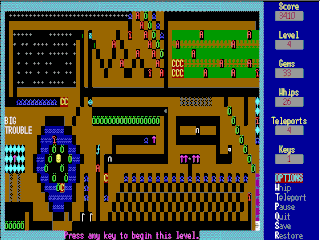
Kroz is a series of Roguelike video games created by Scott Miller for IBM PC compatibles. The first episode in the series, Kingdom of Kroz, was released in 1987 as Apogee Software's first game. It was also published on Big Blue Disk #20. Kroz introduced the scheme of the first episode being free and charging money for additional episodes, a technique which defined the business model for Apogee and was adopted by other MS-DOS shareware publishers.
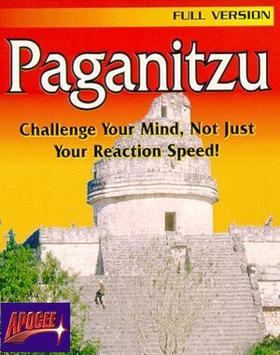
Paganitzu is a puzzle video game created by Keith Schuler and published by Apogee Software for IBM PC compatibles in 1991. It is the sequel to Chagunitzu. The player controls Alabama "Al" Smith, who works his way through an ancient Aztec pyramid while solving Sokoban-like puzzles.
George Broussard is an American video game producer and designer. He is one of the creators of the Duke Nukem series, along with Todd Replogle, Allen Blum, and Scott Miller.

PowerSlave, known as Exhumed in Europe and 1999 AD: Resurrection of the Pharaoh in Japan, is a first-person shooter video game developed by Lobotomy Software and published by Playmates Interactive Entertainment in North America, and BMG Interactive in Europe and Japan. It was released in North America, Europe and Japan, for the Sega Saturn, PlayStation, and MS-DOS over the course of a year from late 1996 to late 1997. On May 24, 2015, Powerslave EX, an unofficial remake of the PlayStation version appeared on GitHub. The MS-DOS version of PowerSlave was added to the GOG store on November 19, 2020.

Bio Menace is a 1993 game developed and published by Apogee Software for MS-DOS. A 2D multidirectional scrolling platform game, it was built on a licensed version of id Software's Commander Keen game engine. Apart from the engine and music, all in-game content was created by the game's designer, Jim Norwood. In 2014, the game was re-released on Steam, and in 2015 on GOG.com with support for Microsoft Windows, macOS, and Linux.
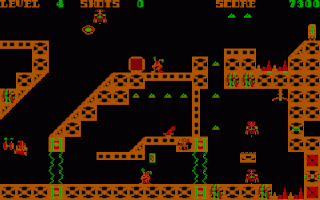
Monuments of Mars is a third-person puzzle-platform game developed by Scenario Software for MS-DOS and compatible systems. It was published by Apogee Software. The game consists of four 20-level episodes, the first episode being shareware, the rest being commercial software. It is similar to the games Arctic Adventure and Pharaoh's Tomb but uses an unrelated engine.

Boppin' is a puzzle-oriented video game created by Jennifer Diane Reitz in 1991, developed under the company name Accursed Toys and published by Karmasoft for the Amiga computer. Around that time Karmasoft held a level design contest. The game sold poorly with 284 copies, so Jennifer got it republished by Apogee Software with up to 256 colors on screen. Due to mature content containing blood and seppuku, Apogee included a disclaimer in the manual that the game contained potentially offensive imagery, as well as part of a manifesto from Accursed Toys stating that their games were produced for an audience of adult gamers who are mostly 25 and older.

Alien Carnage, originally released as Halloween Harry, is a side-scrolling platform game developed by Interactive Binary Illusions and SubZero Software, and distributed by Apogee Software. The game features 256-colour VGA graphics and background music in MOD format. Alien Carnage is composed of four episodes. The first episode was released as shareware, and the rest were distributed commercially. In May 2007, John Passfield and 3D Realms released Alien Carnage as freeware. In 2014, the game was re-released with Windows support.

Arctic Adventure is a platform game written for DOS, published by Apogee Software. It is the sequel to Pharaoh's Tomb. The protagonist, Nevada Smith, is an archaeologist searching for a Viking treasure in the Arctic. It was re-released on Steam in 2015 with support for Windows and macOS.
The video game Duke Nukem Forever spent more than 14 years in development, from 1997 to 2011. It is a first-person shooter for Windows, PlayStation 3 and Xbox 360, developed by 3D Realms, Triptych Games, Gearbox Software and Piranha Games. It is the sequel to the 1996 game Duke Nukem 3D, as part of the long-running Duke Nukem video game series. Intended to be groundbreaking, it became an infamous example of vaporware due to its severely protracted development schedule. Director George Broussard, one of the creators of the original Duke Nukem game, announced the development in 1997, and promotional information for the game was released from 1997 until its release in 2011.

Commander Keen in Invasion of the Vorticons is a three-part episodic side-scrolling platform video game developed by Ideas from the Deep and published by Apogee Software in 1990 for MS-DOS. It is the first set of episodes of the Commander Keen series. The game follows the titular Commander Keen, an eight-year-old child genius, as he retrieves the stolen parts of his spaceship from the cities of Mars, prevents a recently arrived alien mothership from destroying landmarks on Earth, and hunts down the leader of the aliens, the Grand Intellect, on the alien home planet. The three episodes feature Keen running, jumping, and shooting through various levels while opposed by aliens, robots, and other hazards.

Commander Keen in Goodbye, Galaxy is a two-part episodic side-scrolling platform video game developed by id Software and published by Apogee Software in 1991 for DOS. It consists of the fifth and sixth episodes of the Commander Keen series, though they are numbered as the fourth and fifth, as Commander Keen in Keen Dreams is not part of the main continuity. The game follows the titular Commander Keen, an eight-year-old child genius, as he first journeys through the Shadowlands to rescue the Gnosticenes so they may ask the Oracle how the Shikadi plan to destroy the galaxy, and then through the Shikadi's Armageddon Machine to stop them. The two episodes feature Keen running, jumping, and shooting through various levels while opposed by aliens, robots, and other hazards.

Commander Keen in Aliens Ate My Babysitter is a side-scrolling platform video game developed by id Software and published by FormGen in December 1991 for DOS. It is the seventh episode of the Commander Keen series, though it is numbered as the sixth, as Commander Keen in Keen Dreams is outside of the main continuity. The game follows the titular Commander Keen, an eight-year-old child genius, as he journeys through an alien world to rescue his kidnapped babysitter. The game features Keen running, jumping, and shooting through various levels while opposed by aliens, robots, and other hazards.
















